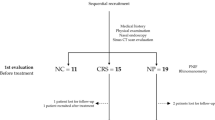Abstract
The global population is aging, with the over-65 age group expected to double in the USA by 2030. Three subcategories of elderly people have been identified: “young old” (from 65 to 74 years), “older old” (from 75 to 84) and “oldest old” (85 or more). Rhinosinusitis is a common disease that affects more than 31 million people in the USA every year. Nasal obstruction is one of the most common symptoms in patients affected by rhinosinusitis. An accurate nasal obstruction evaluation in the elderly is becoming of increasing interest for medical doctors, especially for geriatricians. Peak nasal inspiratory flow (PNIF) is a cheap and easy method for assessing nasal patency. The purpose of the study was to compare young old normal PNIF values with older old normal PNIF values. Charts relating PNIF normal values in the elderly with various explanatory variables have been provided. PNIF measurements were performed in 113 volunteers aged 65–84 years. One hundred and five of them fulfilled the study criteria and were self-reported healthy elderly. None of them complained of nasal symptoms. Data were statistically analyzed and figures and tables were produced relating PNIF to height, sex and age. PNIF values decreased with age (p = 0.0053) and were significantly lower in the “older old” sub-cohort than in the “young old” group (p = 0.007). Nasal obstruction in the elderly is a common problem and appropriate diagnosis and treatment are important for improving their quality of life. The measurement of PNIF could be useful in evaluating elderly patients who complain of nasal obstruction.



Similar content being viewed by others
References
Fokkens WJ, Lund VJ, Mullol J, Bachert C, Alobid I, Baroody F, Cohen N, Cervin A, Douglas R, Gevaert P, Georgalas C, Goossens H, Harvey R, Hellings P, Hopkins C, Jones N, Joos G, Kalogjera L, Kern B, Kowalski M, Price D, Riechelmann H, Schlosser R, Senior B, Thomas M, Toskala E, Voegels R, de Wang Y, Wormald PJ (2012) European position paper on rhinosinusitis and nasal polyps 2012. Rhinol Suppl 23:1–298
Ottaviano G, Marioni G, Staffieri C, Giacomelli L, Marchese-Ragona R, Bertolin A, Staffieri A (2011) Effects of sulfurous, salty, bromic, iodic thermal water nasal irrigations in nonallergic chronic rhinosinusitis: a prospective, randomized, double-blind, clinical, and cytological study. Am J Otolaryngol 32:235–239
Nyenhuis SM, Mathur SK (2013) Rhinitis in older adults. Curr Allergy Asthma Rep 13:171–177
Aging and old age as risk factors for multiple primary tumors. http://grants.nih.gov/grants/guide/pa-files/PA-99-030.html
Holmström M, Scadding GK, Lund VJ, Darby YC (1990) Assessment of nasal obstruction. A comparison between rhinomanometry and nasal inspiratory peak flow. Rhinology 28:191–196
Prescott CAJ, Prescott KE (1995) Peak nasal inspiratory flow measurement: an investigation in children. Int J Pediatr Otorhinolaryngol 32:137–141
Van Spronsen E, Ebbens FA, Fokkens WJ (2012) Normal peak nasal inspiratory flow rate values in healthy children aged 6 to 11 years in the Netherlands. Rhinology 50:22–25
Ottaviano G, Scadding GK, Coles S, Lund VJ (2006) Peak nasal inspiratory flow. Normal range in adult population. Rhinology 44:32–35
Ottaviano G, Lund VJ, Coles S, Staffieri A, Scadding GK (2008) Does peak nasal inspiratory flow relate to peak expiratory flow? Rhinology 46:200–203
Papachristou A, Bourli E, Aivazi D, Futzila E, Papastavrou Th, Kostandinidis Th, Maratou E, Ilonidis G, Aivazis V (2008) Normal peak nasal inspiratory flow rate values in Greek children and adolescents. Hippokratia 12:94–97
Klossek JM, Lebreton JP, Delagranda A, Dufour X (2009) PNIF measurement in a healty French population. A prospective study about 234 patients. Rhinology 47:389–392
Bouzgarou MD, Saad HB, Chouchane A, Cheikh IB, Zbidi A, Dessanges JF, Tabka Z (2011) North African reference equation for peak nasal inspiratory flow. J Laryngol Otol 125:595–602
da Cunha Ibiapina C, de Andrade CR, Moreira Camargos PA, Goncalves Alvim C, Augusto Cruz A (2011) References values for peak nasal inspiratory flow in children and adolescent in Brazil. Rhinology 49:304–308
Ottaviano G, Scadding GK, Scarpa B, Accordi D, Staffieri A, Lund VJ (2012) Unilateral peak nasal inspiratory flow, normal values in adult population. Rhinology 50:386–392
Ottaviano G, Lund VJ, Nardello E, Scarpa B, Frasson G, Staffieri A, Scadding GK Comparison between unilateral PNIF and rhinomanometry in healthy and obstructed noses. Rhinology (in press)
Hopkins C, Gillett S, Slack R, Lund VJ, Browne JP (2009) Psychometric validity of the 22-item Sinonasal Outcome Test. Clin Otolaryngol 34:447–454
van Spronsen E, Ebbens FA, Fokkens WJ (2012) Normal peak nasal inspiratory flow rate values in healthy children aged 6 to 11 years in the Netherlands. Rhinology 50:22–25
Gwozdz W, Sousa-Poza A. Ageing, health and life satisfaction of the oldest old: an analysis for Germany. http://ftp.iza.org/dp4053.pdf
Neves MC, Neves YC, Mendes CM, Bastos MN, Camelier AA, Queiroz CF, Mendoza BF, Lemos AC, Junior AD (2013) Evaluation of atopy in patients with COPD. J Bras Pneumol 39:296–305
Brozek JL, Bousquet J, Baena-Cagnani CE, Bonini S, Canonica GW, Casale TB, van Wijk RG, Ohta K, Zuberbier T, Schünemann HJ (2010) Allergic Rhinitis and its Impact on Asthma (ARIA) guidelines: 2010 revision. J Allergy Clin Immunol 126:466–476
Slavit DH, Lipton RJ, Kern EB, McCaffrey TV (1990) Rhinolift operation in the treatment of the aging nose. Otolaryngol Head Neck Surg 103:462–467
Havas TE. Nasal obstruction in the elderly. http://www.earnosethroat.com.au
Ramey JT, Bailen E, Lockey RF (2006) Rhinitis medicamentosa. J Investig Allergol Clin Immunol 16:148–155
Slavin RG (2009) Treating rhinitis in the older population: special considerations. Allergy Asthma Clin Immunol 5:9
Yepes-Nuñez JJ, Bartra J, Muñoz-Cano R, Sánchez-López J, Serrano C, Mullol J, Alobid I, Sastre J, Picado C, Valero A (2013) Assessment of nasal obstruction: correlation between subjective and objective techniques. Allergol Immunopathol 41:397–401
Acknowledgments
We are deeply indebted to the language editing by Professor Dennis Marino, Padova.
Conflict of interest
None
Author information
Authors and Affiliations
Corresponding author
Rights and permissions
About this article
Cite this article
Ottaviano, G., Lund, V.J., Nardello, E. et al. Peak nasal inspiratory flow: a useful and handy tool for the diagnosis of nasal obstruction in the elderly. Eur Arch Otorhinolaryngol 271, 2427–2431 (2014). https://doi.org/10.1007/s00405-013-2875-4
Received:
Accepted:
Published:
Issue Date:
DOI: https://doi.org/10.1007/s00405-013-2875-4




